Lab 4-3: Confidence Intervals#
Example of calculating confidence intervals for a least squares linear regression model.
import numpy as np
import pandas as pd
import scipy.stats as stats
import matplotlib.pyplot as plt
%matplotlib inline
We are working with the snow pillow data again, measurements of snow water equivelent at two different locations. Load the data file.
# snow pillow (snow water equivalent) example data
data = pd.read_csv('../data/pillows_example.csv')
# Assigning my values to variables x and y for ease of use below
x = data['SLI_max'].values
y = data['BLC_max'].values
First, plot the data to get an idea of what it looks like.
Does it look like we should try and fit a linear model to this?
Does the variance in y values change as we move along the x axis (heteroscedasticity)?
fig, ax = plt.subplots(nrows=1, ncols=1, figsize=(7,7), tight_layout=True)
# Scatterplot of original data
ax.scatter(x, y, c='k', label='Original Data')
# Add legend
plt.legend(loc='lower right');
# Add axes labels and title
ax.set_xlabel('Slide Canyon Maximum Annual SWE (mm)')
ax.set_ylabel('Blue Canyon Maximum Annual SWE (mm)')
ax.set_title('SWE Scatterplot');
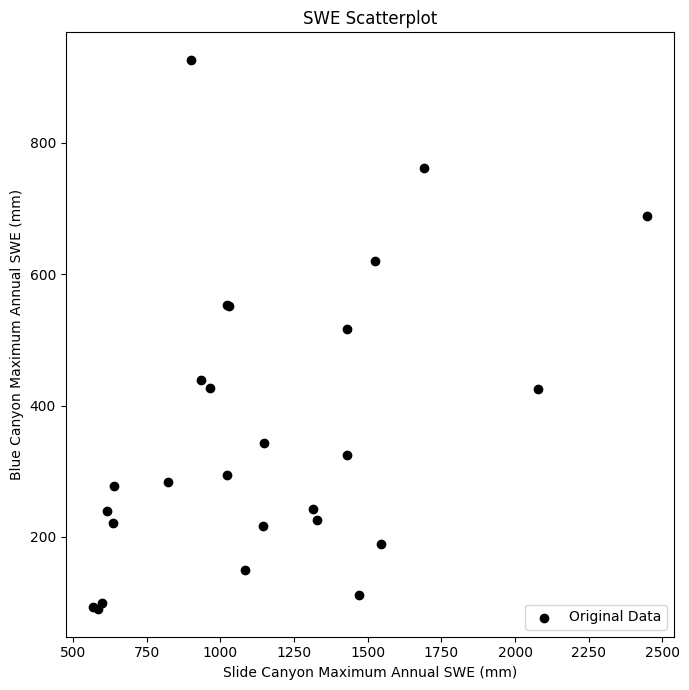
Honestly, not really. But lets go ahead for the sake of the example.
Least Squares Linear Regression#
Compute our least squares linear regression parameters: B1 (the slope), and B0 (the y intercept)
\(B_1 = \displaystyle \frac{n(\sum_{i=1}^{n}x_iy_i)-(\sum_{i=1}^{n}x_i)(\sum_{i=1}^{n}y_i)}{n(\sum_{i=1}^{n}x_i^2)-(\sum_{i=1}^{n}x_i)^2}\)
\(B_0 = \displaystyle \frac{(\sum_{i=1}^{n}y_i)-B_1(\sum_{i=1}^{n}x_i)}{n} = \bar{y} - B_1\bar{x}\)
n = len(x)
B1 = ( n*np.sum(x*y) - np.sum(x)*np.sum(y) ) / ( n*np.sum(x**2) - np.sum(x)**2 ) # B1 parameter, slope
B0 = np.mean(y) - B1*np.mean(x) # B0 parameter, y-intercept
print('B0 : {}'.format(np.round(B0,4)))
print('B1 : {}'.format(np.round(B1,4)))
B0 : 127.9143
B1 : 0.1997
We can now compute our predicted y values (\(\hat{y}\))
\(\hat{y}_i = B_0 + B_1x_i\)
(here we’ll use our original x values as the input)
y_predicted = B0 + B1*x
Compute our residuals \((y_i - \hat{y}_i)\)
residuals = (y - y_predicted)
And then go ahead and compute, the Sum of Square Errors (\(SSE\)), the Total Sum of Squares (\(SST\)), and we’ll also need the \(SST_x\) (total sum of squares in the x dimension).
\(SSE = \displaystyle\sum_{i=1}^{n} (y_i - \hat{y}_i)^2\)
\(SST = \displaystyle\sum_{i=1}^{n} (y_i - \bar{y}_i)^2\)
\(SST_x = \displaystyle\sum_{i=1}^{n} (x_i - \bar{x}_i)^2\)
Compute our coefficient of correlation, \(r\)
\(r^2 = 1 - \displaystyle \frac{SSE}{SST}\)
and finally our standard error, \(s\)
\(s = \sqrt{\displaystyle\frac{SSE}{(n-2)}}\)
# sum of squared errors
sse = np.sum(residuals**2)
# total sum of squares (y)
sst = np.sum( (y - np.mean(y))**2 )
# total sum of squares (x)
sst_x = np.sum( (x - np.mean(x))**2 )
# correlation coefficient
r_squared = 1 - sse/sst
r = np.sqrt( r_squared )
# standard error of regression
s = np.sqrt(sse/(n-2))
# Printing these out so we can see them
print('SSE : {}'.format(np.round(sse,2)))
print('SST : {}'.format(np.round(sst,2)))
print('SSTx : {}'.format(np.round(sst_x,2)))
print('R^2 : {}'.format(np.round(r_squared,3)))
print('R : {}'.format(np.round(r,3)))
print('s : {}'.format(np.round(s,3)))
SSE : 999651.24
SST : 1219919.85
SSTx : 5524345.88
R^2 : 0.181
R : 0.425
s : 204.089
Plot the data with our linear regression model
fig, ax = plt.subplots(nrows=1, ncols=1, figsize=(7,7), tight_layout=True)
# Scatterplot of original data
ax.scatter(x, y, c='k', label='Original Data')
# Plot the regression line, we only need two points to define a line, use xmin and xmax
ax.plot([x.min(), x.max()], [B0 + B1*x.min(), B0 + B1*x.max()] , '-r', label='Least Squares Linear Regression Model')
# Plot the mean line, we only need two points to define a line, use xmin and xmax
ax.plot([x.min(), x.max()], [y.mean(), y.mean()] , '--m', label='Mean Y')
# Add legend
plt.legend(loc='lower right');
# Add axes labels and title
ax.set_xlabel('Slide Canyon Maximum Annual SWE (mm)')
ax.set_ylabel('Blue Canyon Maximum Annual SWE (mm)')
ax.set_title('Linear Regression Model');
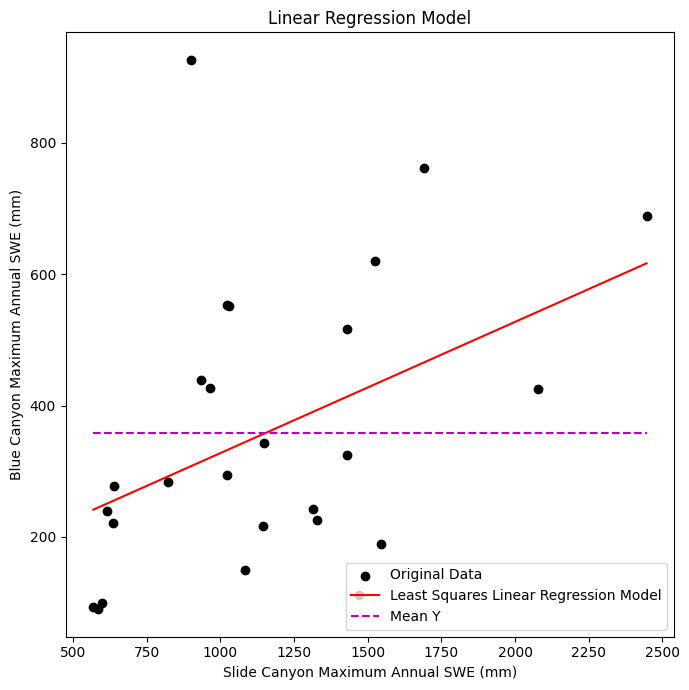
Plot the residuals to make sure they don’t have any sort of trend or pattern and are roughly normally distributed
fig, [ax2, ax3] = plt.subplots(nrows=1, ncols=2, figsize=(8,4), tight_layout=True)
# Plot the residuals
ax2.plot(x,residuals,'.')
ax2.set_title('Residuals versus X');
# Plot a histogram of the residuals
ax3.hist(residuals, bins=10)
ax3.set_title('Residuals Histogram');
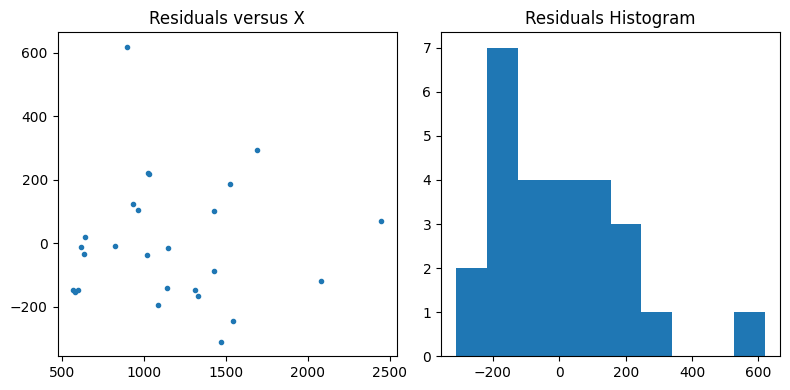
Confidence Interval for the Slope (B1)#
Compute the confidence intervals around our B1 parameter, the slope
We first specify our \(\alpha\) for our chosen level of confidence (95%), and our degrees of freedom \(dof = n - 2\)
# our alpha for 95% confidence
alpha = 0.05
# length of the dataset
n = len(x)
print(n)
# degrees of freedom
dof = n - 2
26
Now, compute the Standard Error of the Gradient (Slope):
\(s_{B_1} = \displaystyle \frac{s}{\sqrt{SST_x}} \)
# standard error of the gradient (slope)
sB1 = s/np.sqrt(sst_x)
This follows a t-distribution, find the t-value that corresponds with our \(\alpha\) and \(dof\)
# t-value for alpha/2 with n-2 degrees of freedom
t = stats.t.ppf(1-alpha/2, dof)
Compute the upper and lower limits for the B1 parameter
# compute the upper and lower limits on our B1 (slope) parameter
B1_upper = B1 + t * sB1
B1_lower = B1 - t * sB1
# compute the corresponding upper and lower B0 values (y intercepts)
B0_upper = y.mean() - B1_upper*x.mean()
B0_lower = y.mean() - B1_lower*x.mean()
Plot the data, linear regression model, and confidence intervals for B1
fig, ax = plt.subplots(nrows=1, ncols=1, figsize=(7,7), tight_layout=True)
# Scatterplot of original data
ax.scatter(x, y, c='k', label='Original Data')
# Plot the regression line, we only need two points to define a line, use xmin and xmax
ax.plot([x.min(), x.max()], [B0 + B1*x.min(), B0 + B1*x.max()] , '-r', label='Least Squares Linear Regression Model')
# Plot the mean line, we only need two points to define a line, use xmin and xmax
ax.plot([x.min(), x.max()], [y.mean(), y.mean()] , '--m', label='Mean Y')
# Plot the upper and lower confidence limits for the standard error of the gradient (slope)
ax.plot([x.min(), x.max()], [B0_upper + B1_upper*x.min(), B0_upper + B1_upper*x.max()] , '--r', label='Upper B0 confidence limit (95%)')
ax.plot([x.min(), x.max()], [B0_lower + B1_lower*x.min(), B0_lower + B1_lower*x.max()] , '--r', label='Upper B0 confidence limit (95%)')
# Add legend
plt.legend(loc='lower right');
# Add axes labels and title
ax.set_xlabel('Slide Canyon Maximum Annual SWE (mm)')
ax.set_ylabel('Blue Canyon Maximum Annual SWE (mm)')
ax.set_title('Linear Regression Model with Confidence Intervals');
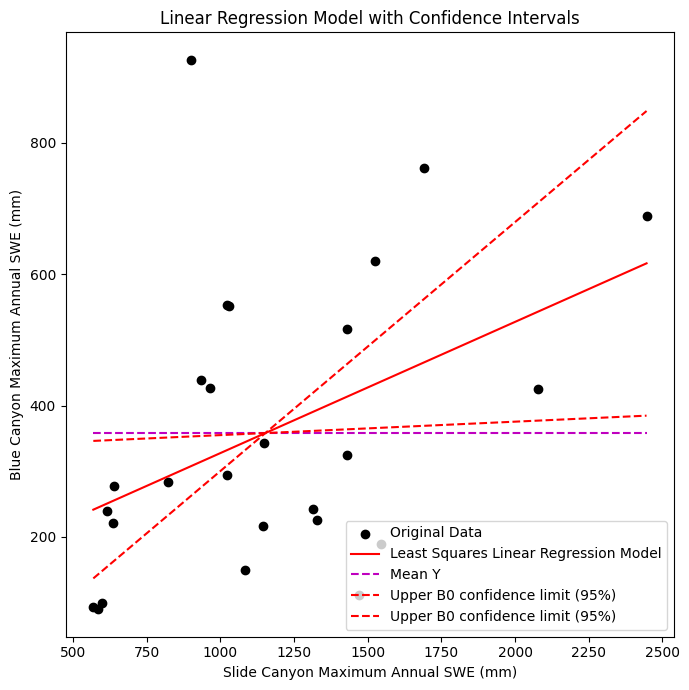
Confidence Interval for Predicted Values of y#
Compute confidence limits for the predicted values of y
To compute confidence limits on our predicted values of y, we need to predict some values of y first!
For the prediction intervals, I’m naming the variables p_x and p_y, in the equations below these correspond to \(x^*\) and \(\hat{y}^*\).
# an array of x values
p_x = np.linspace(x.min(),x.max(),100)
# using our model parameters to predict y values
p_y = B0 + B1*p_x
For some value \(x^*\) we want to predict a corresponding \(y^*\) using our model.
\(\hat{y}^* = \hat{B}_0 + \hat{B}_1x^*\)
But what is the undercertainty of the \(\hat{y}^*\) we’ll calculate? We can compute a prediction interval for a given confidence (such a 95%).
The error of our prediction is the difference between the “true” value of \(y^*\) for \(x^*\), and our predicted \(\hat{y}^*\):
\(B_0 + B_1x^* - \hat{B}_0 + \hat{B}_1x^*\)
The variance of this prediction error (\(\sigma_{E_P}^2\)) will help define our prediction intervals, and can be computed as follows:
\(\sigma_{E_p}^2(x^*) = s^2 \Bigg[ 1 + \displaystyle\frac{1}{n} + \displaystyle\frac{n(x^*-\bar{x})^2}{n \sum{x_i^2} + (\sum{x_i})^2} \Bigg]\)
or
\(\sigma_{E_p}^2(x^*) = s^2 \Bigg[ 1 + \displaystyle\frac{1}{n} + \displaystyle\frac{(x^*-\bar{x})^2}{SST_x} \Bigg]\)
Now compute our error of prediction (\(\sigma_{E_p}\)) for each p_x:
sigma_ep = np.sqrt( s**2 * (1+ 1/n + ( ( n*(p_x-x.mean())**2 ) / ( n*np.sum(x**2) - np.sum(x)**2 ) ) ) )
The lower and upper confidence limits based on predicted y and confidence intervals (which follow a t-distribution) can be computed as:
\(y^* \pm t_{\frac{\alpha}{2},n-2} \cdot \sigma_{E_p}(x^*)\)
alpha = 0.05
n = len(p_x)
dof = n - 2
t = stats.t.ppf(1-alpha/2, dof)
p_y_lower = p_y - t * sigma_ep
p_y_upper = p_y + t * sigma_ep
Finally, plot the upper and lower confidence limits for the predicted y values
fig, ax = plt.subplots(nrows=1, ncols=1, figsize=(7,7), tight_layout=True)
# Scatterplot of original data
ax.scatter(x, y, c='k', label='Original Data')
# Plot the regression line, we only need two points to define a line, use xmin and xmax
ax.plot([x.min(), x.max()], [B0 + B1*x.min(), B0 + B1*x.max()] , '-r', label='Least Squares Linear Regression Model')
# Plot the mean line, we only need two points to define a line, use xmin and xmax
ax.plot([x.min(), x.max()], [y.mean(), y.mean()] , '--m', label='Mean Y')
# Plot the mean x line
plt.axvline(x.mean(),c='k', linestyle='--', label='Mean X Value')
# Plot the upper and lower confidence limits for the standard error of the gradient (slope)
ax.plot([x.min(), x.max()], [B0_upper + B1_upper*x.min(), B0_upper + B1_upper*x.max()] , '--r', label='Upper B0 confidence limit (95%)')
ax.plot([x.min(), x.max()], [B0_lower + B1_lower*x.min(), B0_lower + B1_lower*x.max()] , '--r', label='Upper B0 confidence limit (95%)')
# Plot confidence limits on our predicted Y values
ax.plot(p_x, p_y_upper, ':b', label='Upper Y prediction interval (95%)')
ax.plot(p_x, p_y_lower, ':b', label='Lower Y prediction interval (95%)')
# Add legend
plt.legend(loc='lower right');
# Add axes labels and title
ax.set_xlabel('Slide Canyon Maximum Annual SWE (mm)')
ax.set_ylabel('Blue Canyon Maximum Annual SWE (mm)')
ax.set_title('Linear Regression Model with Confidence Intervals');
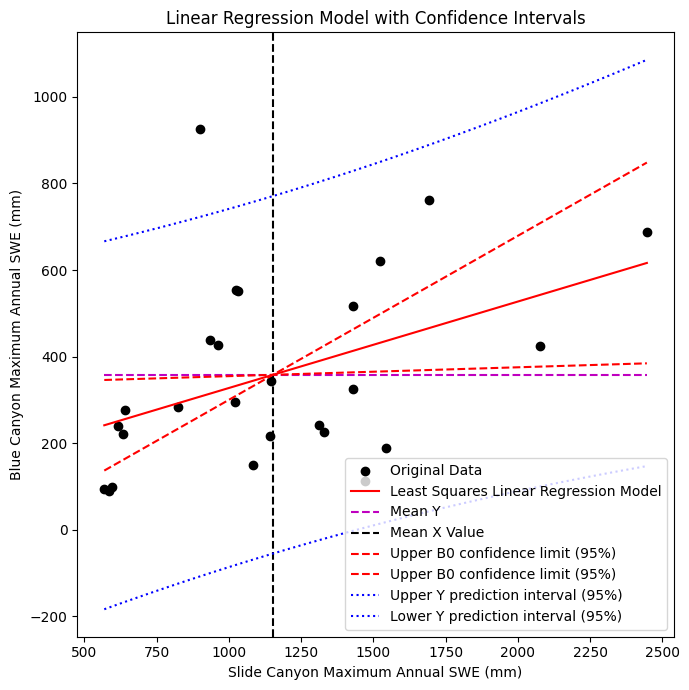
Our upper and lower predicted y confidence limits look almost parallel, but are they?
To inspect this, we can plot the difference between the two versus x to see how our 95% interval changes shape as we move along the x axis, and see that they “pivot” around the mean x value of the original dataset.
p_y_difference = p_y_upper - p_y_lower
plt.plot(p_x, p_y_difference, label='p_y_difference')
plt.axvline(x.mean(),c='k', linestyle='--', label='Mean X Value')
plt.legend()
plt.xlabel('Prediction Input (Blue Canyon SWE, mm)')
plt.ylabel('Difference Between Upper and Lower\nY Prediction Confidence Bounds ($\Delta$mm)')
plt.title('Difference Between Upper and Lower\nY Prediction 95% Confidence Bounds');
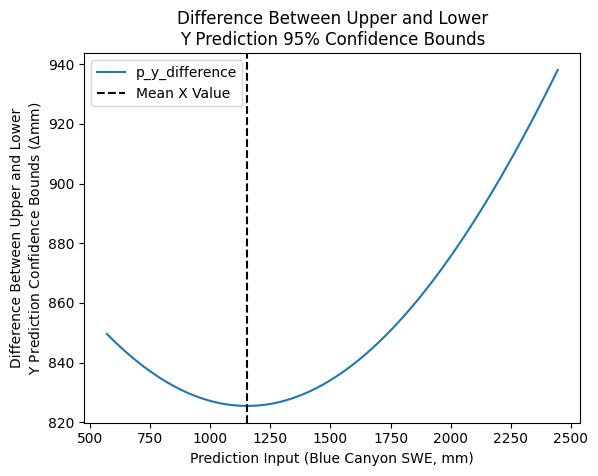
As we’d expect, they’re not quite parallel (they vary along the x-axis) and are narrowest at \(\bar{x}\) where we have higher confidence in our ability to make predictions with the model.
Linear regression with scipy#
How do we do this quickly in python?
As always, there are a few options, two of the easier ones that are in packages we already have here are:
scipy.stats.linregress()we’ve used this previouslynumpy.polyfit()we can fit a 1st order polynomial (linear function)
I’m going to use the scipy function below (remember, this outputs our standard error of the gradient for us already):
B1, B0, r, p, sB1 = stats.linregress(x, y)
Compute the upper and lower limits for the B1 parameter
# our alpha for 95% confidence
alpha = 0.05
# length of the original dataset
n = len(x)
# degrees of freedom
dof = n - 2
# t-value for alpha/2 with n-2 degrees of freedom
t = stats.t.ppf(1-alpha/2, dof)
# compute the upper and lower limits on our B1 (slope) parameter
B1_upper = B1 + t * sB1
B1_lower = B1 - t * sB1
# compute the corresponding upper and lower B0 values (y intercepts)
B0_upper = y.mean() - B1_upper*x.mean()
B0_lower = y.mean() - B1_lower*x.mean()
Create some predictions values, compute our error of prediction (sigma_ep) for each p_x, then the lower and upper confidence limits (for 95%) can be computed as:
# an array of x values
p_x = np.linspace(x.min(),x.max(),100)
# using our model parameters to predict y values
p_y = B0 + B1*p_x
# calculate the standard error of the predictions
sigma_ep = np.sqrt( s**2 * (1 + 1/n + ( ( n*(p_x-x.mean())**2 ) / ( n*np.sum(x**2) - np.sum(x)**2 ) ) ) )
# our chosen alpha
alpha = 0.05
# compute our degrees of freedom with the length of the predicted dataset
n_p = len(p_x)
dof = n_p - 2
# get the t-value for our alpha and degrees of freedom
t = stats.t.ppf(1-alpha/2, dof)
# compute the upper and lower limits at each of the p_x values
p_y_lower = p_y - t * sigma_ep
p_y_upper = p_y + t * sigma_ep
Plot it all again
fig, ax = plt.subplots(nrows=1, ncols=1, figsize=(7,7), tight_layout=True)
# Scatterplot of original data
ax.scatter(x, y, c='k', label='Original Data')
# Plot the mean line, we only need two points to define a line, use xmin and xmax
ax.plot([x.min(), x.max()], [y.mean(), y.mean()] , '--m', label='Mean Y')
# Plot the mean x line
plt.axvline(x.mean(),c='k', linestyle='--', label='Mean X Value')
# Plot the linear regression model
ax.plot([x.min(), x.max()], [B0 + B1*x.min(), B0 + B1*x.max()], '-r', label='Least Squares Linear Regression Model')
# Plot the upper and lower confidence limits for the standard error of the gradient (slope)
ax.plot([x.min(), x.max()], [B0_upper + B1_upper*x.min(), B0_upper + B1_upper*x.max()] , '--r', label='Upper B0 confidence limit (95%)')
ax.plot([x.min(), x.max()], [B0_lower + B1_lower*x.min(), B0_lower + B1_lower*x.max()] , '--r', label='Upper B0 confidence limit (95%)')
# Plot confidence limits on our predicted Y values
ax.plot(p_x, p_y_upper, ':b', label='Upper Y prediction interval (95%)')
ax.plot(p_x, p_y_lower, ':b', label='Lower Y prediction interval (95%)')
# Add legend
plt.legend(loc='lower right');
# Add axes labels and title
ax.set_xlabel('Slide Canyon Maximum Annual SWE (mm)')
ax.set_ylabel('Blue Canyon Maximum Annual SWE (mm)')
ax.set_title('SWE Scatterplot');
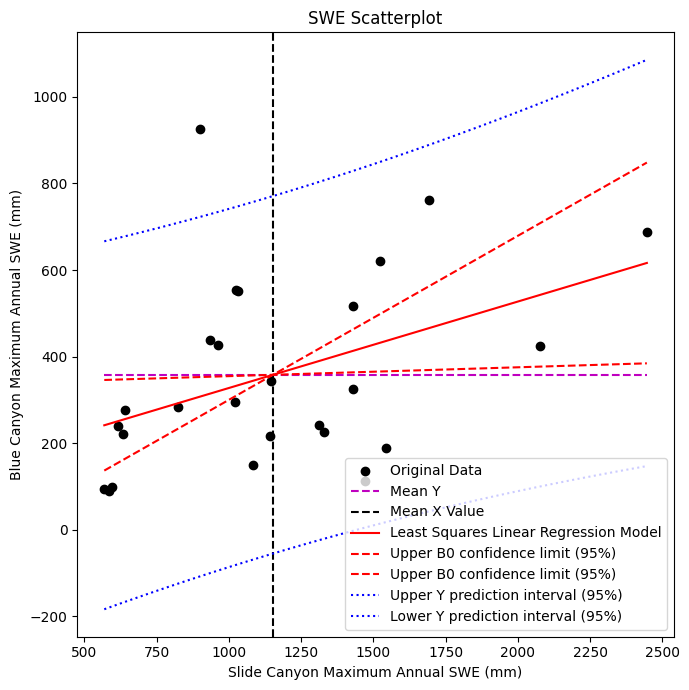
Linear Regression and Confidence#
Look back at your solution to Problem 2 part D of Homework 4, with the streamflow records for the Columbia River measured at The Dalles, Oregon (dalles_flow.csv).
A. As in Problem 2 part D of Homework 4, again, plot the predictions and residuals for the two different prediction models for the training period (1879-1933), and plot the model predictions for the 1858-1878 data for the two different models.
B. Estimate the 95% confidence intervals for the annual flow predictions from 1858-1878, and plot them as a timeseries (estimates each year) with the central tendency (the central tendency is the prediction from the regression model).
